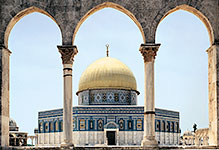
Islam
Mosques and Islamic Architecture

#03040153
Mongol warriors on horseback from Rashid Al-Din's (1247 - 1318) enormous univers...

#03040154
Turkish book painting: Archangel Gabriel inspires Mohammed; 16th century.

#03040155
Nushaba recognising Iskandar by his portrait. (Inscription: The gate of the affl...

#03040156
Iskandar visiting the hermit in his cave. A miniature painting from a sixteenth...

#03040157
The fire ordeal of Siyavush. Siyavush proves his innocence by passing unharmed...

#03040158
The court of Fath 'Ali Shah (1771 - 1834), the second Qajar King of Persia, with...

#03040159
Iskandar (Alexander the Great) meeting the Brahmans. A miniature painting from a...

#03040160
Detail from an illustration of shawl-weavers weaving shawls on a loom. Inscribed...

#03040164
An aged Mullah. Opaque watercolour and gold on paper India or Pakistan; ca. 16...

#03060210
A'isha and the dogs of Al-Hawa'ab. A'isha, one of the wives of the prophet Moham...

#03060227
A scene from the legend of Gazi, riding a tiger. One of the 57 registers of a sc...

#03060245
The Moghul Emperor Babur (reigned 1526-1530) holding a hawk, 1800-1825. Babur wa...